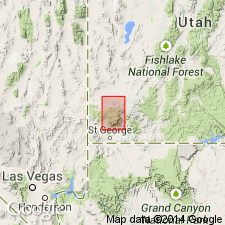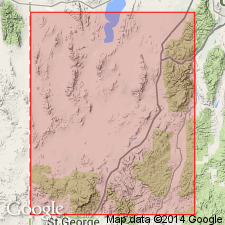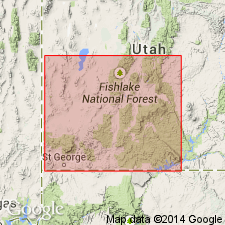
- Usage in publication:
-
- Page Ranch formation
- Modifications:
-
- Named
- Dominant lithology:
-
- Breccia
- Dacite
- Ignimbrite
- AAPG geologic province:
-
- Great Basin province
Summary:
Named for exposures capping mountain northwest of Page Ranch, southern Iron Co, UT, Great Basin province. No type locality designated. Mapped in northern part of study area in Pine Valley Mountains, Washington and Iron Cos. Consists of a lower unit of gray to gray-brown, poorly bedded tuff-breccia and an upper unit of gray-brown to purplish-brown, moderately welded, crystal, biotite dacite ignimbrite with sparse lithic fragments. Only lower unit occurs in areas of Pinto Spring and north of New Harmony; only upper unit occurs in area west of Grassy Flat and on Atchinson Mountain. Only on mountain northwest of Page Ranch are both lower and upper units present. Bedded tuff-breccia contains occasional subangular boulders up to six feet in diameter in a matrix of smaller lithic fragments and broken mineral crystals; unit is resistant to erosion and weathers to rounded cliffs. Tuff-breccia is believed to be result of hot mudflows (lahars) or rather cool nuees ardentes. Thickness ranges up to 600 ft. Unconformably overlies Atchinson formation (new); unconformably underlies Pine Valley latite (new). Stratigraphic chart; cross sections. Assigned Tertiary age.
Source: GNU records (USGS DDS-6; Denver GNULEX).

- Usage in publication:
-
- Page Ranch formation
- Modifications:
-
- Revised
- AAPG geologic province:
-
- Great Basin province
Summary:
Is a composite unit exposed in an east-facing scarp 2 mi northwest of Page Ranch and 1 mi southwest of Old Irontown Historic Site, Washington and Iron Cos, UT in the Great Basin province. Divided into the newly named Irontown member at base and the Kane Point tuff [member] at top. Irontown consists of crudely bedded fanglomerate made up chiefly of subangular blocks of the Harmony Hills tuff [member] and other Quichapa ignimbrites. Kane Point consists of vitric ignimbrite of rhyolitic composition. Thickness not stated. Overlies Rencher formation. Oligocene-Miocene age.
Source: GNU records (USGS DDS-6; Denver GNULEX).

- Usage in publication:
-
- Page Ranch Formation*
- Modifications:
-
- Revised
- AAPG geologic province:
-
- Great Basin province
Summary:
A silicic crystal poor ash-flow tuff formerly called Kane Point Tuff Member, top member of Page Ranch Formation is removed from the Page Ranch. The tuff is assigned formation rank and renamed Racer Canyon Tuff. Name Kane Point is abandoned. Page Ranch Formation as revised overlies Rancher Formation or some unnamed volcanic rocks, and underlies Racer Canyon Tuff. Correlation chart shows Page Ranch in the Bull Valley and Pine Valley Mountains and in the Iron Springs district of Iron Co., UT, Great Basin province. Miocene age.
Source: GNU records (USGS DDS-6; Denver GNULEX).
For more information, please contact Nancy Stamm, Geologic Names Committee Secretary.
Asterisk (*) indicates published by U.S. Geological Survey authors.
"No current usage" (†) implies that a name has been abandoned or has fallen into disuse. Former usage and, if known, replacement name given in parentheses ( ).
Slash (/) indicates name conflicts with nomenclatural guidelines (CSN, 1933; ACSN, 1961, 1970; NACSN, 1983, 2005, 2021). May be explained within brackets ([ ]).

